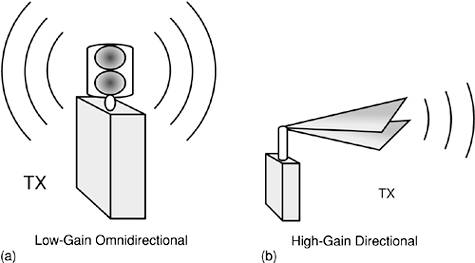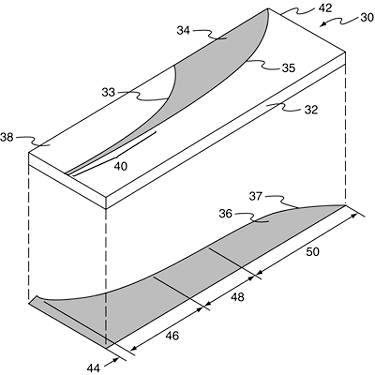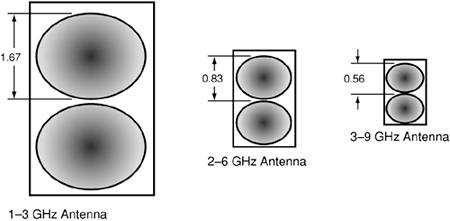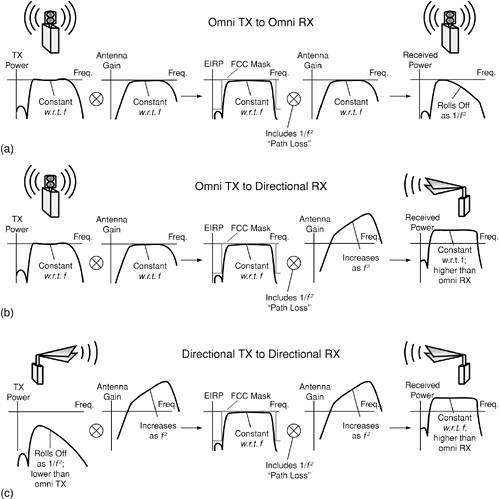Section 2.3. UWB Antennas
2.3. UWB Antennas[1]
An antenna is a transducer that converts guided electromagnetic energy in a transmission line to radiated electromagnetic energy in free space. Antennas also can be viewed as impedance transformers, coupling between an input or line impedance and the impedance of free space. The imminent widespread commercial deployment of UWB systems has sparked renewed interest in the subject of ultra-wideband antennas. The power levels authorized by the FCC mean that every decibel counts in a UWB systemas much as or perhaps even more than in a standard narrowband system. Thus, an effective UWB antenna is a critical part of an overall UWB system design. UWB antennas have been in active commercial use for decades. In a sense, even the venerable AM broadcast band antenna is "UWB" since it covers a band from 535 KHz to 1705 KHz for a fractional bandwidth in excess of 100 percent. Because a high-quality broadcast AM antenna is really a tuned antenna designed to pick up an individual narrowband (10 KHz) channel, the effective fractional bandwidth is really only 0.6 to 1.9 percent, and only one channel can be received at a time. This is a particularly stark example, but it highlights the difficulty with traditional UWB antennas: they are typically "multi-narrowband" antennas instead of antennas optimized to receive a single coherent signal across their entire operating bandwidth. Some modulation schemes are more tolerant of antenna variations than others. For instance, a multiband or OFDM approach may be less vulnerable to dispersion or other variations across an antenna's operational band. Nevertheless, a UWB system requires an antenna capable of receiving on all frequencies at the same time. Thus, antenna behavior and performance must be consistent and predictable across the entire band. Ideally, pattern and matching should be stable across the entire band. In addition, a UWB antenna is preferentially nondispersive, having a fixed phase center. If waveform dispersion occurs in a predictable fashion, it may be possible to compensate for it, but in general it is desirable to radiate similar waveforms in all directions. A log-periodic antenna is an example of a dispersive antenna. Larger scale components radiate low-frequency components, while smaller scale components radiate high-frequency components. The result is a chirplike, dispersive waveform. Worse, the waveform will vary at different azimuthal angles around the antenna. Again, a multiband or OFDM approach may be more tolerant of dispersive antennas. By contrast, a small-element antenna, such as a planar elliptical dipole, tends to radiate a more compact, nondispersive waveform, similar to a "Gaussian W." This behavior is illustrated in Figure 2-5. A small-element antenna tends to be not only nondispersive but also more compact. Hence, these antennas are preferred in many applications. Figure 2-5. (a) A log-periodic antenna (left) has a dispersive waveform (right). (b) An elliptical dipole (left) has a nondispersive waveform (right).
The aim of this section is to provide an overview of and an introduction to UWB antennas. The next subsectionexplains key UWB antenna concepts and discusses system and network considerations for UWB antennas. 2.3.1. UWB Antenna ConceptsA wide variety of antennas are suitable for use in ultra-wideband applications. Some of these are described elsewhere in a historical survey [9]. UWB antennas may be classified as directional or nondirectional. They may further be classified as either electric or magnetic antennas. These classifications as well as the various types of UWB antennas will be considered in turn. Directionality of AntennasHigh-gain or directional antennas concentrate energy into a narrower solid angle than omnidirectional antennas. An isotropic antenna has a gain of 0 dBi by definition (such an antenna is not physically realizable, at least not in terms of instantaneous pattern). In fact, dBi means "decibels relative to an ideal isotropic antenna." A typical dipole antenna has a gain of about 2.2 dBi. High-gain horn or reflector antennas may have gains of +10 dBi, +20 dBi, or even more, as shown in Figure 2-6. Antenna efficiency is included in the definition of antenna gain, so a 50 percent efficient (3 dB) dipole will have a gain of about 1.8 dBi. Figure 2-6. (a) An isotropic antenna has a gain of 0 dBi by definition, (b) a small dipole antenna typically has a gain of about 2.2 dBi, and (c) a horn antenna may have a gain of 10 dBi or more.
As shown in Figure 2-6, a directional antenna has high gain, it has a narrow field of view, and it is relatively large in size. An omnidirectional antenna has relatively low gain, it has a wide field of view, and it tends to be relatively small. The fundamental trade-offs with directional antennas are shown in Table 2-1.
Note that regulatory constraints require transmit power to be decreased when using a high-gain directional transmit antenna so as to meet the same peak radiated emission limit. Thus, a high-gain transmit antenna does not add directly to the link budget except insofar as it might reduce emissions in undesired directions. This can potentially reduce clutter and enhance overall system performance or capacity. Of course, a high-gain receive antenna adds directly to link performance and is always desirable where the relatively larger size and narrower field of view can be tolerated. These trade-offs are illustrated in Figure 2-7. Figure 2-7. (a) A low-gain, omnidirectional antenna may be replaced by (b) a high-gain directional antenna, but transmit power must be reduced to meet the same regulatory limit for peak power. Also, a high-gain antenna will tend to be larger and have a narrower field of view than a low-gain omnidirectional one.
Implications of antenna directivity and gain for overall system performance are discussed in Section 2.3.2. Electric or Magnetic AntennasAntennas also can be classified as either electric or magnetic. Electric antennas include dipoles and most horns. These antennas are characterized by intense electric fields close to the antenna. Magnetic antennas include loops and slots and are characterized by intense magnetic fields close to the antenna [10]. Electric antennas are more prone to couple to nearby objects than magnetic antennas. Thus, magnetic antennas are preferred for applications involving embedded antennas. Types of AntennasMany specific kinds of UWB antennas fall within these general categories. Directional antennas include horn and reflector antennas. These antennas can also be implemented in relatively compact planar designs. Small-element antennas, such as dipoles or loops, are preferred for omnidirectional coverage or where space is at a particular premium. Traditional "frequency independent" antennas, such as log periodics or spiral antennas, tend to be larger and can be used only if waveform dispersion across the field of view can be tolerated. UWB antennas can also be combined in arrays [11, 12]. 2.3.2. System and Network Considerations for UWB AntennasTraditional narrowband concepts and techniques often require revision in order to be applied in the UWB context. This section discusses first the problem of antenna matching and then the relationship between directivity and system performance. Matching and Spectral Control in UWB SystemsTraditionally, a narrowband antenna is treated as a black box with given fixed properties. A system designer either accepts the penalties imposed by an antenna's shortcomings or designs a matching network to bridge any impedance gap between the RF front end and the antenna. A clever matching network can conceal a wealth of antenna sins in the narrowband context. Such matching networks become increasingly difficult to construct as the bandwidth increases. In the UWB context, a good impedance match to an antenna must be designed in from first principles, not added as an afterthought. The concept of specifically designing an antenna to have a particular impedance has been understood for some time. For instance, Nester disclosed a planar horn antenna with continuously variable elements [13]. This antenna transitions smoothly from a microstrip to a slotline architecture while maintaining an impedance match. Nester's antenna design is shown in Figure 2-8. Figure 2-8. The continuously tapered slot horn elements of Nester (gray colorization on elements added). A detailed description of this antenna, as well as explanations of each marking on the figure, are available in U.S. Patent 4,500,887 [13].
Calculating the impedance of a slotline horn requires some complicated algorithms [14]. For simplicity in discussion, assume a parallel plate horn antenna with a cross-sectional width w and a height h. Then the impedance of an air gap horn is given approximately by: Equation 2-1
Note that this result is only exact for w >> ~10 h values. Since the free space impedance is Z0 = 377 Consider a hypothetical horn antenna matched to 50 at its feed, with a linear transition from 50 Figure 2-9. (a) A hypothetical tapered horn antenna, with (b) a transition from 50 |
EAN: 2147483647
Pages: 93




 , a 50
, a 50  match requires
match requires 






